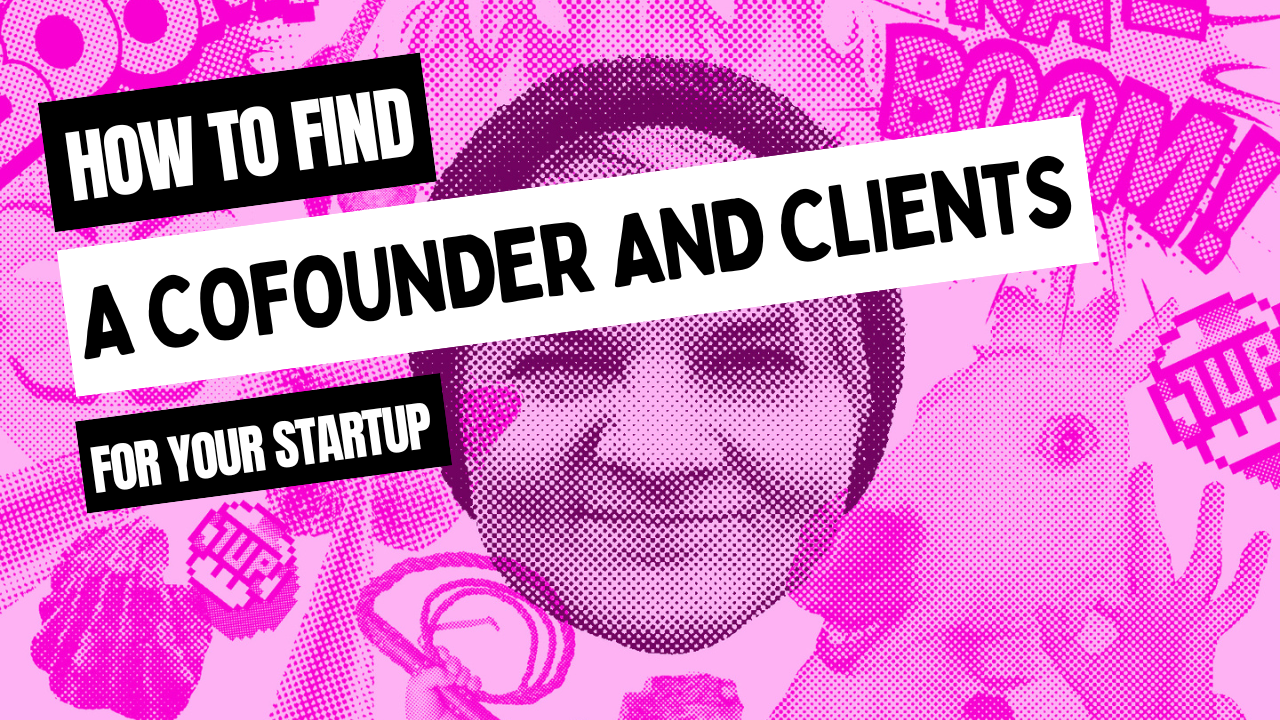How to find a cofounder and first clients for your startup

Startup success depends on strategic planning — and finding the right people is a skill every founder should develop early on. Whether it’s a cofounder, early hires, or your first customers, you must know how to identify the right type of people and how to connect with them.
In a world where startups are easier than ever to launch, they’re still exceedingly complex to run. You have to start preparing long before take-off. Finding the right people will shape the outcome of your business tremendously, so you have to choose wisely.
In this guide, we’ll tackle the ins and outs of how to find a cofounder for a startup as well as how to identify your first clients and win them over.
Why you need a cofounder
Technically speaking, startups can be successful solo expeditions. But you miss out on a lot of opportunities when you forgo a cofounder. Cofounders are sounding boards, visionaries, and confidants. They make your startup go from being a one-person project to a team effort.
Working with a cofounder helps you divide work more evenly, and maximize the impact of your efforts. You also get to work with someone who has strengths and skill sets that complement yours. Cofounders can create a more well-rounded, sturdy foundation for your business.
Entrepreneurship is an adventure, but it’s rife with challenges. You’ll face a lot of obstacles on your journey, and it helps to have someone by your side who’s just as passionate about your startup as you are. That's why especially to succeed in the VC track they also usually want you to have a cofounder.
How to find a cofounder
Finding the right cofounder starts with some questions. You need to know what your business needs before you’ll know who is capable of providing it.
Ask yourself what skills you currency lack. This will help you start building a list of desirable strengths in your ideal cofounder. Ideally, a cofounding team will be dynamically diverse; they’ll have some shared characteristics, but their skill sets are unique enough that they each serve clearly defined roles in the company.
Furthermore, your cofounder needs to complement you, not compete with you. Hiring a clone doesn’t benefit your business, and it could lead to unnecessary stress and strife later. Make sure that you’re clear about what you want.
If you think of your ideal cofounder, you should be able to describe them clearly. Identify the top 3 qualities you’re looking for, and use them as a starting point when you start your search.
Speaking of which…
How do you find a cofounder for a startup?
Outreach is everything for entrepreneurs, and it’s one of the skills that will serve you well throughout your career. The bigger your business becomes, the more people you’ll communicate with. And a strong network is an essential part of every good entrepreneur's toolbox.
Start by using LinkedIn, even if you’re in the pre-founder stage. You have nothing to lose by reaching out to people who pique your interest and pitching your idea to them. If they aren’t interested, ask yourself why.
Lack of interest means your idea needs more work. Not everyone will be ready to jump on board as a cofounder, but if every pitch is turned down, start asking why and build from there.
Make sure that even as an early-stage founder, you know the business you want to create. Understand its value proposition, and have both short-term and long-term goals underscoring your vision.
Master the art of the elevator pitch, and use yours often to connect with people, build a network, and eventually, find the right people to launch your business with.
Key questions to ask a cofounder
- What kind of professional background would benefit your business the most
- What knowledge and skills should they bring to the table?
- What are their own career ambitions?
- How do they handle stress?
- What level of commitment are they willing to make?
- Are you both passionate about the same mission?
- Do your goals align?
When you evaluate a confounder, make sure you look at the person, not just the professional. Someone can meet all your requirements on paper, but there’s no connection. If that’s the case, you’ll never be able to share the type of bond necessary to collaborate and communicate well.
Cofounders have to work together constantly, and they need to get along as both colleagues and people. You can still have personal and professional boundaries, of course. But the connection has to be genuine. You have to trust this person, and they need to trust you equally. There’s no room for secrets, holding back, or second-guessing.
The entire success of your startup will rest on what you and your cofounder create, so, you need someone who is in it for the long haul.
Most importantly, ask yourself if your cofounder is someone you’d be excited to grow with.
How to find your first clients
Startups are fun to build, but when it comes to succeeding, you can’t get anywhere with great ideas alone. All the backing, skills, and teamwork in the world will be for naught if you fail to attract any consumers.
You’d be surprised at how many entrepreneurs actually don’t know who their target audience is. They struggle to find clients because they’ve focused on their business too much from a founder’s perspective.
Flexibility is crucial for an entrepreneur. You have to be able to flip the script, so to speak, and scrutinize your business from the perspective of a prospective client.
When you do that, you can easily identify the greatest products/services, and solutions to market.
Start off by asking yourself the following questions:
- What people would benefit the most from my solutions?
- Where do they work, and what positions do they hold?
Think about where they are, and how they’re most likely to look for a business like yours. How would they go about the buying process? Understand the buyer’s journey, and create a sales funnel that respects your audience’s unique experiences and expectations.
It’s helpful to document this entire process so you can show investors how invested you are in your work and what progress you’re making. Documentation also makes it easier to strategize, review, and revise your outreach approach.
So where do you find clients?
LinkedIn is still a valuable tool here. You can use the site to reach out to potential buyers as well. You will have to slightly tweak your pitch, though. The qualities that attract a cofounder aren’t the same qualities a customer will look for.
It also doesn’t hurt to network as much as possible. Tell your friends and family what you’re doing. Ask them what they think about your ideas. Talk to your investors, who often have great networks.
A great book to read on this is called The Mom Test by Rob Fitzpatrick. It’s all about learning how to ask the right questions to customers that elicit the most insightful, beneficial responses.
Another great way to attract your first clients is to build a strong brand. Post on LinkedIn often, and be active on social media. Figure out where your audience hangs out already, and meet them there rather than trying to get them to come to you.
Having a company blog can make a huge difference in your long-term growth; businesses with blogs get, on average, 97% more inbound links than ones that don’t. Inbound links mean higher ratings on Google, which leads to higher visibility, greater credibility, more traffic, and more leads.
Social media and digital marketing will be your two best friends as you start identifying your ideal clients and reaching out to them. Remember, value sells more than anything else. Use your online content to demonstrate why your solutions matter. Make people feel like there’s no better option by showing them what your business can do.
Clients want visible proof that your solutions work for their needs. Use your online presence to illustrate in various ways how your business works, who it’s built for, and what it helps people achieve.
Don’t ditch cold outreach
They still work — if they’re done right. Cold outreach - especially cold calling has become historically associated with obnoxious, intrusive ads that are disruptive and out-of-touch with people’s desires. However, there are plenty that still work phenomenally well.
LinkedIn is a place where people expect to network, so they are far more likely to respond to messages there. You can also still reach out to people the old-fashioned way by email, if their information is publicly available.
When cold outreach, make sure you avoid:
- Sales talk
- Copy-and-paste pitches
- Pressuring the recipient to respond
Instead, you should:
- Keep it light, conversational, and friendly
- Personalize your message to every potential client
- Make sure your message is contextual
- Offer a clear call-to-action that’s optional
Here’s the deal: If you’re doing something right with your business, people will wait for it. They’ll want to be a part of it because it’s intriguing and poses a great benefit to them.
The bottom line
Finding a cofounder and first clients has more in common than you might think. Being a great speaker who knows how to connect with people will help you naturally sell your business. Your common sense and intuition are highly valuable, and they’ll help you identify the right people early on.
Remember that the reaction of not being interested is a learning experience as well: if you don't get any results (but observe LinkedIn users reading your direct messages), your idea or how you communicate it needs more work.
No spam, no sharing to third party. Only you and me.
